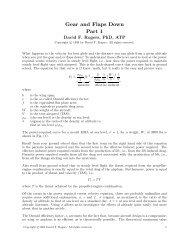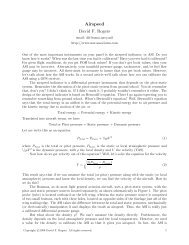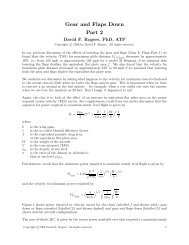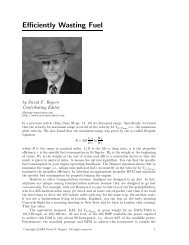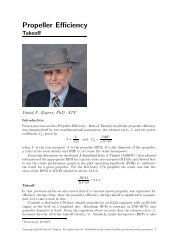Flight Determination of Partial Span Flap Parasite ... - NAR Associates
Flight Determination of Partial Span Flap Parasite ... - NAR Associates
Flight Determination of Partial Span Flap Parasite ... - NAR Associates
You also want an ePaper? Increase the reach of your titles
YUMPU automatically turns print PDFs into web optimized ePapers that Google loves.
maximum flap extension speed. The aircraft tachometer was calibrated against a stroboscopic<br />
tachometer and thereafter used to measure propeller RPM. The aircraft instrument<br />
was used to measure engine manifold pressure in order to determine power available. Mixture<br />
was set to correspond to best power (Ref. 5), i.e., approximately 100 ◦ rich <strong>of</strong> peak<br />
exhaust gas temperature. During the flight tests, aircraft weight varied from 3179 lbs to<br />
2669 lbs for the various flights. Outside air temperature (OAT) varied from 32 to 52 ◦ Ffor<br />
the various data runs. Typically the OAT remained nearly constant for each data run. Manifold<br />
pressure varied from approximately 18.2 Hg to 23.2 Hgin0.5to1 Hg increments,<br />
while propeller speed varied from approximately 1850 to 2500 RPM in approximately 100<br />
RPM increments. The clean configuration tests, i.e., gear and flaps retracted, were conducted<br />
with cowl flaps and all cabin vents closed. The gear down tests were conducted with<br />
cowl flaps open. Typically five or six data points were obtained for each flap setting during<br />
a single flight.<br />
Data Acquisition and Reduction<br />
The true airspeed was determined using the horseshoe heading technique as detailed by<br />
Rogers (Ref. 4) and the references therein. This technique has been shown to be as accurate,<br />
within less than ±1 kt, as a traditional trailing cone or Kiel tube (Ref. 6). Basically the<br />
flight test consists <strong>of</strong> flying three legs with headings ninety degrees apart while recording<br />
the GPS ground speed. Using these GPS ground speeds and headings and solving three<br />
algebraic equations in three unknowns yields the true airspeed, wind direction and wind<br />
speed.<br />
Aircraft weight was determined by subtracting the fuel used from the aircraft gross<br />
weight before engine start. Atmospheric density was determined from measured outside<br />
air temperature and the pressure altitude. Engine brake horsepower was determined from<br />
the manufacture’s engine charts (Ref. 5) for best power mixture using measured manifold<br />
pressure and engine RPM. The propeller efficiency was calculated from polynomial curves<br />
determined from the manufacture’s propeller map (Ref. 7). The results were reduced to a<br />
standard gross weight <strong>of</strong> 3300 lbs at sea level using true airspeed and the technique described<br />
in Appendix A <strong>of</strong> Rogers (Ref. 3). The results <strong>of</strong> these flight tests are shown in Figures 2–4.<br />
The Results<br />
Recalling the classical thrust power required equation for an aircraft with a parabolic<br />
drag polar equipped with a reciprocating engine driving a propeller<br />
THP req = σρ SL<br />
2 fV 3 + 2 1 ( W<br />
σρ<br />
} {{ } SL πe b<br />
parasite<br />
) 2 1<br />
V<br />
} {{ }<br />
effective induced<br />
Multiplying by the true airspeed, V , yields<br />
THP req V = σρ SL<br />
2 fV 4 + 2 1 ( W ) 2<br />
= A + BV<br />
4<br />
(2)<br />
σρ SL πe b<br />
which is a linear relation in V 4 with<br />
A = 2 1 ( W ) 2<br />
and B = σρ SL<br />
σρ SL πe b<br />
2 f (3)<br />
Copyright c○2007-2009 David F. Rogers. All rights reserved. 4<br />
(1)



